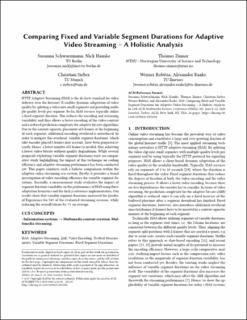| dc.description.abstract | HTTP Adaptive Streaming (HAS) is the de-facto standard for video delivery over the Internet. It enables dynamic adaptation of video quality by splitting a video into small segments and providing multiple quality levels per segment. So far, HAS services typically utilize a fixed segment duration. This reduces the encoding and streaming variability and thus allows a faster encoding of the video content and a reduced prediction complexity for adaptive bit rate algorithms. Due to the content-agnostic placement of I-frames at the beginning of each segment, additional encoding overhead is introduced. In order to mitigate this overhead, variable segment durations, which take encoder placed I-frames into account, have been proposed recently. Hence, a lower number of I-frames is needed, thus achieving a lower video bitrate without quality degradation. While several proposals exploiting variable segment durations exist, no comparative study highlighting the impact of this technique on coding efficiency and adaptive streaming performance has been conducted yet. This paper conducts such a holistic comparison within the adaptive video streaming eco-system. Firstly, it provides a broad investigation of video encoding efficiency for variable segment durations. Secondly, a measurement study evaluates the impact of segment duration variability on the performance of HAS using three adaptation heuristics and the dash.js reference implementation. Our results show that variable segment durations increased the Quality of Experience for 54% of the evaluated streaming sessions, while reducing the overall bitrate by 7% on average. | en_US |
